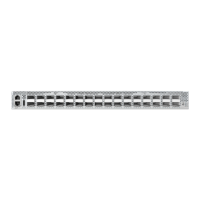C
HAPTER
35
| Spanning Tree Commands
– 821 –
cause forwarding loops, they can pass directly through to the spanning tree
forwarding state. Specifying Edge Ports provides quicker convergence for
devices such as workstations or servers, retains the current forwarding
database to reduce the amount of frame flooding required to rebuild
address tables during reconfiguration events, does not cause the spanning
tree to initiate reconfiguration when the interface changes state, and also
overcomes other STA-related time out problems. However, remember that
Edge Port should only be enabled for ports connected to an end-node
device.
EXAMPLE
Console(config)#interface ethernet 1/5
Console(config-if)#spanning-tree edge-port
Console(config-if)#
spanning-tree link-
type
This command configures the link type for Rapid Spanning Tree and
Multiple Spanning Tree. Use the no form to restore the default.
SYNTAX
spanning-tree link-type {auto | point-to-point | shared}
no spanning-tree link-type
auto - Automatically derived from the duplex mode setting.
point-to-point - Point-to-point link.
shared - Shared medium.
DEFAULT SETTING
auto
COMMAND MODE
Interface Configuration (Ethernet, Port Channel)
COMMAND USAGE
◆ Specify a point-to-point link if the interface can only be connected to
exactly one other bridge, or a shared link if it can be connected to two
or more bridges.
◆ When automatic detection is selected, the switch derives the link type
from the duplex mode. A full-duplex interface is considered a point-to-
point link, while a half-duplex interface is assumed to be on a shared
link.
◆ RSTP only works on point-to-point links between two bridges. If you
designate a port as a shared link, RSTP is forbidden. Since MSTP is an
extension of RSTP, this same restriction applies.

